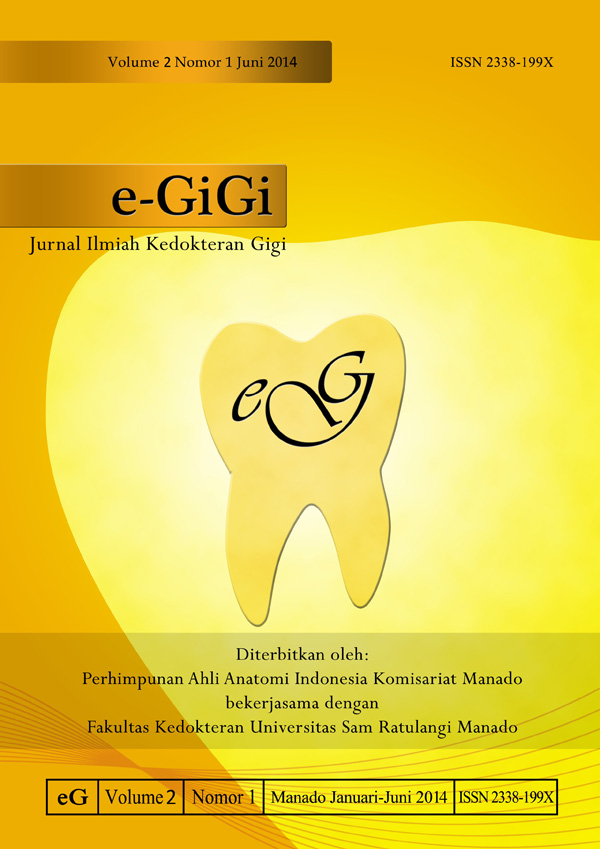GAMBARAN PEMELIHARAAN KEBERSIHAN GTL AKRILIK PADA MASYARAKAT KELUHARAN BATU PUTIH BAWAH
DOI:
https://doi.org/10.35790/eg.2.1.2014.4684Abstract
Abstract: Removable acrylic denture is a prosthesis that replaces the natural teeth that is useful to fill the empty space and restore jaw occlusion, phonetics and retain the remaining oral tissues to stay healthy, and can be removed by the patient. This study aimed to describe the maintenance of the removable denture hygiene in communities with 1611 inhabitants in Batu Putih Bawah. This was a descriptive study with 60 samples obtained by using total sampling method. The results showed that there were 19 respondents (31.6%) had dirty dentures, while 21 respondents (35%) had very dirty dentures. About 66.6% of respondents had poor denture hygiene. There were 73.3% respondents that had never received verbal instructions, and 95% respondents had never received written instruction about hygiene maintenance after installation. Based on the frequency of cleaning, 95% respondents mentioned that they cleaned their dentures every day, and as much as 65% respondents cleaned theirs twice a day. Based on the times of cleaning, 38.3% respondents cleaned their dentures in the morning and in the afternoon while they took baths and 6.7% before sleeping at night. All respondents cleaned their dentures with toothpaste or soap. Conclusion: Based on the clinical condition, most of the respondents in Batu Putih Bawah had dirty removable acrylic dentures.
Keywords: maintenance of denture hygiene, removable acrylic denture
Â
Â
Abstrak: GTL akrilik adalah alat bantu yang menggantikan gigi asli yang berguna untuk mengisi daerah rahang yang kosong, mengembalikan oklusi dan fonetik, mempertahankan jaringan mulut yang masih ada agar tetap sehat, serta dapat dilepas oleh pasien. Penelitian ini bertujuan untuk mengetahui gambaran pemeliharaan kebersihan GTL akrilik pada masyarakat kelurahan Batu Putih Bawah dengan populasi 1611 jiwa. Penelitian bersifat deskriptif dan pengambilan sampel menggunakan metode total sampling. Sampel berjumlah 60 responden. Instrumen penelitian yang digunakan yakni kuesioner. Hasil penelitian menunjukkan bahwa 19 responden (31,6%) memiliki gigi tiruan kotor dan 21 responden (35%) dengan gigi tiruan sangat kotor. Jadi sekitar 66,6% responden memiliki kebersihan gigi tiruan yang buruk. Hasil penelitian menunjukkan 73,3% responden pengguna GTL akrilik tidak pernah menerima instruksi secara lisan, dan 95%Â responden tidak pernah menerima instruksi dalam bentuk tulisan tentang cara pemeliharaan kebersihan pasca pemasangan. Berdasarkan frekuensi pembersihan 95% responden mengaku membersihkan GTL akrilik setiap hari, dan 65% membersihkan GTL akrilik dua kali sehari. Pemeliharaan kebersihan berdasarkan waktu menunjukkan 38,3% responden membersihkan GTL akrilik sewaktu mandi pagi dan sore hari dan 6,7% sewaktu sebelum tidur. Berdasarkan cara pembersihan semua responden (100%) menjawab bahwa mereka membersihkan GTL akrilik menggunakan pasta gigi atau sabun. Simpulan: Berdasarkan hasil penelitian diperoleh umumnya responden di Batu Putih Bawah mempunyai kondisi klinis GTL akrilik yang kotor.
Kata kunci: pemeliharaan kebersihan, GTL akrilik
Downloads
How to Cite
Issue
Section
License
COPYRIGHT
Authors who publish with this journal agree to the following terms:
Authors hold their copyright and grant this journal the privilege of first publication, with the work simultaneously licensed under a Creative Commons Attribution License that permits others to impart the work with an acknowledgment of the work's origin and initial publication by this journal.
Authors can enter into separate or additional contractual arrangements for the non-exclusive distribution of the journal's published version of the work (for example, post it to an institutional repository or publish it in a book), with an acknowledgment of its underlying publication in this journal.
Authors are permitted and encouraged to post their work online (for example, in institutional repositories or on their website) as it can lead to productive exchanges, as well as earlier and greater citation of the published work (See The Effect of Open Access).






